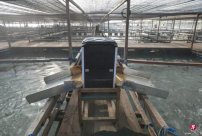
I went to Hong Kong a while ago and played with my family to the famous tourist attraction Ocean Park for a long time.It is like the combination of Singapore Zoo, SEA Oceanas and Universal Studios. It has both sea and land animals to watch, as well as stimulating game facilities such as roller coasters.However, the most surprising thing that day was that the dolphin performance was incorporated into the propaganda session of "Food in the Earth".
Several hosts sang one by one, driving the audience to raise their hands to the "L" gesture representing "Eat Local", and also listed the benefits of choosing local fishery and agricultural products: fresh ingredients, supporting local fishery and agriculture, and contributing to carbon reduction.This marine park's "Fresh Earth" campaign is also on the official website. It publishes local fishing farms and the list of restaurants selling local ingredients for public inquiries.
Hong Kong released the blueprint for sustainable fishery and agricultural development at the end of last year. It formulated the goal of developing modern high -density breeding models, establishing pilot urban farms, attracting young people to join, etc.30%of the nutritional needs of Chinese people) are quite similar.
With the experience of the affected supply chain during the epidemic, grain security guarantee has become a more important issue in Singapore.However, the market performance has not increased at high speeds because of this high value. Many fishermen and farmers have closed down in the past few years, including large -scale and once regarded as "model students" in the industry; to reach "The goal of 30 · 30 "may not be difficult.
The development of local fishery and agriculture has stumbled all the way, some are not good at operating, and some are affected by uncontrollable factors such as inflation after the epidemic.The price of local agricultural products is high, and it is also one of the reasons for consumers. In addition, in recent years, prices have risen, and consumers have become more sensitive to prices.
Local agricultural products do not have the price advantage, but the victory does not have to import from abroad. The ingredients are fresh and the carbon footprints are low. It is in line with the pursuit of quality of young people's attention, supporting environmental protection, and providing fresh and safe food for children.To capture the hearts of this consumer group, you may consider the promotion of tourist attractions gathered in young people and young families like the Ocean Park, or refer to some foreign supermarkets and seafood markets, to cooked, do now, do it.The mode of eating has played the "fresh" of local agricultural products to the extreme.
I noticed when I lived in Melbourne a few years ago that the local spirit of the local enterprises is very strong. The vegetable market emphasizes the sale of Victoria fruits and vegetables.Victoria's agricultural products are gimmicks, bringing diners for diners' dining experience from farm to dining tables.The positive feedback between consumers and industry shows a sense of regional pride, and gradually affects my consumption trend.
We may still have a certain distance from Australia, but in the past few years, we can still see many people support local agricultural products.For example, the Barkean Vegetable Stall near the home, the boss once proudly said that a vegetable garden is only supplied to a large chain supermarket. She is the only Pasar booth that can get the goods.It is difficult to verify these words, but from her enthusiastic introduction of various vegetables, at least the enthusiasm for local agricultural products.In addition, not long ago, I also noticed at a certain coffee shop that the eggs that only use the real estate under the menu are specifically indicated under the menu.This is a good beginning.
The government has stated that it may be reviewed in the near future. It is worth looking forward to how Singapore will develop local fishery agriculture next.Consumers must also use action support to ensure the sustainable development of local farming agriculture.
( The author is the Deputy Editor -in -Chief of the morning campus )




